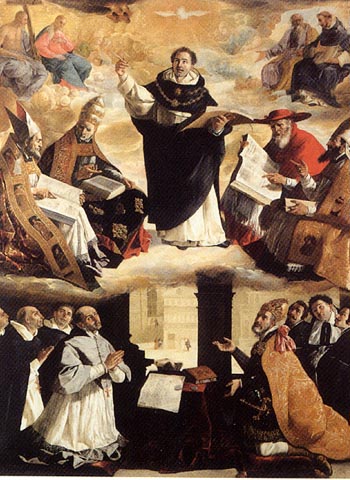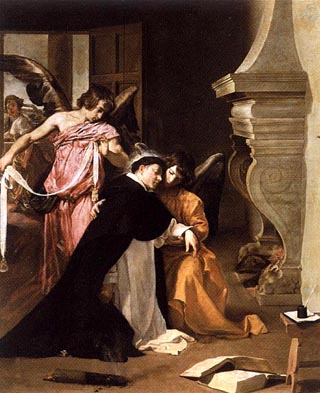 |
The Saint of the Day
St. Thomas Aquinas, March 7
Prof. Plinio Corrêa de Oliveira
Biographical selection:
“In truth, St. Thomas possessed all the moral virtues in a very high degree, and so closely bound together in his soul that they formed one whole in charity [the love of God], which, as he himself states, ‘informs the acts of all the other virtues.’ If, however, we seek to discover the specific and particular characteristics of his sanctity, the first thing that appears is a virtue that gives St. Thomas a certain likeness to the angelic natures. We refer to that chastity which he preserved unsullied in a crisis of the most pressing danger. Because of this he was judged worthy to receive from the Angels a mystic girdle [belt of purity] ….

St. Thomas Aquinas surrounded by the Doctors of the Church
|
“The most distinctive feature, however, of the sanctity of St. Thomas is what St. Paul describes as the ‘word of wisdom’ [sermo sapientia], and the union of the two forms of wisdoms – the acquired and the infused – with which nothing accords so well as humility, devotion to prayer, and the love of God.
“That humility was the foundation upon which the other virtues of Thomas were based is clear to anyone who considers how submissively he obeyed a lay brother in the course of their communal life. It is no less obvious to anyone reading his writings, which manifest such great respect for the Fathers of the Church. As Leo XIII noted, ‘Because of his utmost reverence for the doctors of antiquity, he seems to have inherited in some way the intellect of all.’
“But the most magnificent illustration of his humility is to be found in the fact that he devoted the faculties of his divine intellect not to gain glory for himself, but to the advancement of truth. Most philosophers as a rule are eager to establish their own reputations, but St. Thomas strove to efface himself completely in the teaching of his philosophy so that the light of heavenly truth might shine with its own effulgence.”
Excerpt from the Encyclical Studiorum ducem, of June 29, 1923, by Pope Pius XI
Comments of Prof. Plinio:
There are several interesting points in this selection. First, let me give you a clarification regarding his purity. When Pope Pius XI referred to the crisis St. Thomas passed through, he was alluding to a particular episode.

St. Thomas is girded by Angels with a mystical belt of purity after his proof of chastity
|
St. Thomas wanted to be a Dominican, but his father, who was a noble from southern Italy, opposed his decision. He ordered his son to be imprisoned in a tower to see if isolating the youth from everyone would make him leave aside his vocation. Instead of abandoning it, he took advantage of the solitude to pray and study.
Seeing this, his father did another bad thing. He arranged for a public woman to visit St. Thomas to invite him to sin against purity. It was a chilly day, and a fire was burning in the fireplace of the room where St. Thomas was locked. When the woman approached to tempt him, he took a stick of burning wood from the fire and threatened to burn the woman should she come any closer. She fled in panic.
Having thus conquered the temptation of impurity, he received the visit of an Angel who rewarded him with a kind of mystical girdle, that is, an invisible protection against the temptations of impurity. So this great angel, St. Thomas of Aquinas, was free of the temptations of the flesh that could disturb the progress of his mind or damage his studies and the great work he did for the Catholic Church.
Second, regarding his obedience, it is remarkable that St. Thomas, on the order of his superiors, always had a lay brother whom he obeyed. This person was incomparably inferior to St. Thomas, but he nonetheless exerted an authority over the Saint rendered by the vow of obedience. And St. Thomas obeyed him. It is admirable to consider a person with the sanctity and culture of St. Thomas curbing himself and submitting to the yoke of a person so less learned and probably much less holy than himself. This helps to explain what Pope Pius XI was referring to when he said humility was the foundation of the virtues practiced by St. Thomas.
Third, the encyclical also observed quite aptly how St. Thomas effaced himself in his teaching. It is truly magnificent to see how the man does not seem to be present in his writings. One has, as it were, philosophical and theological reasoning in its pure state. One does not feel any hint of the presence of the man. The only thing that appears is Catholic doctrine. One would say that Catholic doctrine speaks through his lips.
I offer you these few comments in honor of the great St. Thomas Aquinas, asking him to help us to love Catholic doctrine as he did, and to protect us against so many occasions of impurity that present themselves in our days.


  | | Prof. Plinio Corrêa de Oliveira | |
The Saint of the Day features highlights from the lives of saints based on comments made by the late Prof. Plinio Corrêa de Oliveira. Following the example of St. John Bosco who used to make similar talks for the boys of his College, each evening it was Prof. Plinio’s custom to make a short commentary on the lives of the next day’s saint in a meeting for youth in order to encourage them in the practice of virtue and love for the Catholic Church. TIA thought that its readers could profit from these valuable commentaries.
The texts of both the biographical data and the comments come from personal notes taken by Atila S. Guimarães from 1964 to 1995. Given the fact that the source is a personal notebook, it is possible that at times the biographic notes transcribed here will not rigorously follow the original text read by Prof. Plinio. The commentaries have also been adapted and translated for TIA’s site.
|
Saint of the Day | Home | Books | CDs | Search | Contact Us | Donate

© 2002- Tradition in Action, Inc. All Rights Reserved
|
 |

|